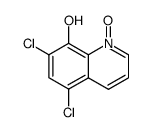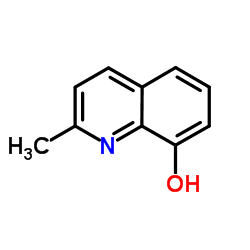chlorquinaldol

chlorquinaldol structure
|
Common Name | chlorquinaldol | ||
|---|---|---|---|---|
| CAS Number | 72-80-0 | Molecular Weight | 228.075 | |
| Density | 1.5±0.1 g/cm3 | Boiling Point | 350.7±37.0 °C at 760 mmHg | |
| Molecular Formula | C10H7Cl2NO | Melting Point | 108-112 °C (dec.)(lit.) | |
| MSDS | Chinese USA | Flash Point | 165.9±26.5 °C | |
| Symbol |

GHS07 |
Signal Word | Warning | |
Use of chlorquinaldolChlorquinaldol is a mono-hydroxyquinoline, is an antifungal and antibacterial, used for topical treatment of skin conditions and vaginal infections. |
| Name | chlorquinaldol |
|---|---|
| Synonym | More Synonyms |
| Description | Chlorquinaldol is a mono-hydroxyquinoline, is an antifungal and antibacterial, used for topical treatment of skin conditions and vaginal infections. |
|---|---|
| Related Catalog |
| Density | 1.5±0.1 g/cm3 |
|---|---|
| Boiling Point | 350.7±37.0 °C at 760 mmHg |
| Melting Point | 108-112 °C (dec.)(lit.) |
| Molecular Formula | C10H7Cl2NO |
| Molecular Weight | 228.075 |
| Flash Point | 165.9±26.5 °C |
| Exact Mass | 226.990463 |
| PSA | 33.12000 |
| LogP | 4.21 |
| Vapour Pressure | 0.0±0.8 mmHg at 25°C |
| Index of Refraction | 1.679 |
| Storage condition | 2-8°C |
| Water Solubility | Insoluble |
CHEMICAL IDENTIFICATION
HEALTH HAZARD DATAACUTE TOXICITY DATA
MUTATION DATA
|
| Symbol |

GHS07 |
|---|---|
| Signal Word | Warning |
| Hazard Statements | H302 |
| Precautionary Statements | P301 + P312 + P330 |
| Personal Protective Equipment | dust mask type N95 (US);Eyeshields;Gloves |
| Hazard Codes | Xn:Harmful |
| Risk Phrases | R22;R36/37/38 |
| Safety Phrases | S26-S36-S36/37/39 |
| RIDADR | UN 2811 6.1/PG 3 |
| WGK Germany | 3 |
| RTECS | VC5600000 |
| HS Code | 2933499090 |
|
~62% 
chlorquinaldol CAS#:72-80-0 |
| Literature: Organic Letters, , vol. 16, # 3 p. 864 - 867 |
|
~% 
chlorquinaldol CAS#:72-80-0 |
| Literature: CH229982 , ; |
| Precursor 2 | |
|---|---|
| DownStream 0 | |
| HS Code | 2933499090 |
|---|---|
| Summary | 2933499090. other compounds containing in the structure a quinoline or isoquinoline ring-system (whether or not hydrogenated), not further fused. VAT:17.0%. Tax rebate rate:13.0%. . MFN tariff:6.5%. General tariff:20.0% |
|
Purity determination of gynalgin bactericidal tablets with HPLC method.
Acta Pol. Pharm. 70(1) , 51-8, (2013) The study was aimed at developing a simple HPLC method for the determination of the content of impurities in Gynalgin, a two-component preparation. A satisfactory separation was performed on 250 x 4.6... |
|
|
[Allergies to 8-hydroxyquinoline derivatives].
Derm. Beruf Umwelt. 36(3) , 86-90, (1988) Evaluation of our standardized test results from 1972 to 1983 indicated Vioform allergies in 1.2% of all cases and Sterosan allergies in 1.1%. Our results are within the spectrum found in the literatu... |
|
|
In vitro activities of cloxyquin (5-chloroquinolin-8-ol) against Mycobacterium tuberculosis.
Antimicrob. Agents Chemother. 51 , 1105-6, (2007) The in vitro activities of cloxyquin (5-chloroquinolin-8-ol) against 9 standard strains and 150 clinical isolates of Mycobacterium tuberculosis were studied. The MICs ranged from 0.062 to 0.25 microg/... |
| 5,7-Dichloro-2-methyl-8-quinolinol |
| 5,7-Dichloro-8-hydroxyquinaldine |
| 2-methyl-5,7-dichloro-8-hydroxyquinoline |
| 5,7-Dichloro-8-quinaldinol |
| Clorquinaldol |
| Chloroquinaldol |
| EINECS 200-789-3 |
| Gynotherax |
| 5,7-dichloro-2-methylquinolin-8-ol |
| 2-methylchloroxine |
| 5,7-Dichlor-2-methylchinolin-8-ol |
| Saprosan |
| Sterosan |
| 5,7-dichloro-2-methyl-8-hydroxy-quinoline |
| 8-Quinolinol, 5,7-dichloro-2-methyl- |
| chlorquinaldol |
| Chlorchinaldolum |
| Chlorquinaldolum |
| MFCD00023984 |




